名词单复数的讲解小学英语语法
- 格式:docx
- 大小:17.20 KB
- 文档页数:8
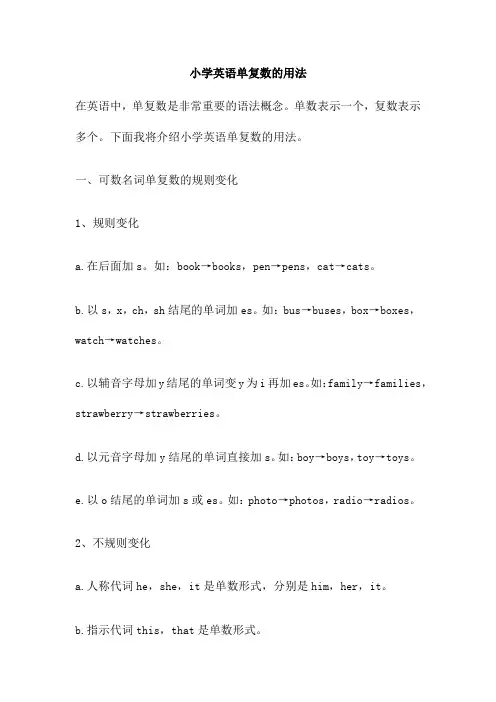
小学英语单复数的用法在英语中,单复数是非常重要的语法概念。
单数表示一个,复数表示多个。
下面我将介绍小学英语单复数的用法。
一、可数名词单复数的规则变化1、规则变化a.在后面加s。
如:book→books,pen→pens,cat→cats。
b.以s,x,ch,sh结尾的单词加es。
如:bus→buses,box→boxes,watch→watches。
c.以辅音字母加y结尾的单词变y为i再加es。
如:family→families,strawberry→strawberries。
d.以元音字母加y结尾的单词直接加s。
如:boy→boys,toy→toys。
e.以o结尾的单词加s或es。
如:photo→photos,radio→radios。
2、不规则变化a.人称代词he,she,it是单数形式,分别是him,her,it。
b.指示代词this,that是单数形式。
c.动词和名词有单数和复数两种形式。
一般来说,主语是单数时用单数动词或名词,主语是复数时用复数动词或名词。
d.在and连接的两个名词作主语时,谓语动词用复数形式。
e.由there、here、in、at等引导的句子中,名词是单数时用单数动词,名词是复数时用复数动词。
f.由some、any、no等引导的句子中,名词是单数时用单数动词,名词是复数时用复数动词。
g.由what、who等引导的句子中,谓语动词的数由后面的名词决定。
如果是单数名词则用单数动词,如果是复数名词则用复数动词。
h.在疑问句中,如果主语是单数,则谓语动词用单数形式;如果主语是复数,则谓语动词用复数形式。
i.在特殊疑问句中,如果主语是单数,则谓语动词用单数形式;如果主语是复数,则谓语动词用复数形式。
在小学英语中,单复数的概念是十分重要的。
许多单词在添加后缀或者变换形式时,都需要考虑到单复数的问题。
而正确地使用单复数形式,也是英语写作和口语表达中的基本要求。
在英语中,单数和复数的概念与中文的相同。

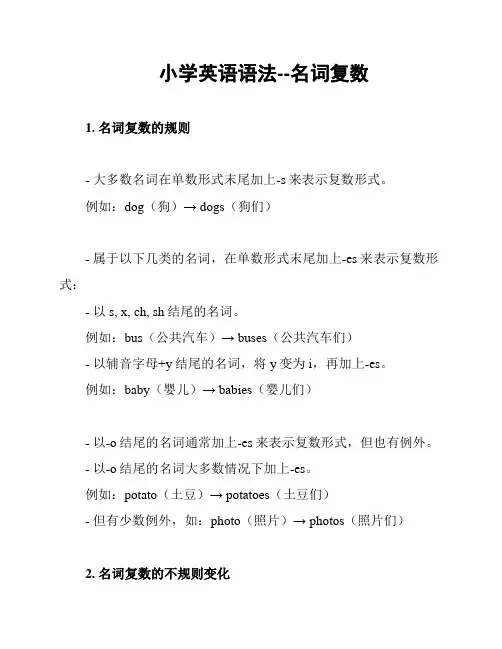
小学英语语法--名词复数1. 名词复数的规则- 大多数名词在单数形式末尾加上-s来表示复数形式。
例如:dog(狗)→ dogs(狗们)- 属于以下几类的名词,在单数形式末尾加上-es来表示复数形式:- 以s, x, ch, sh结尾的名词。
例如:bus(公共汽车)→ buses(公共汽车们)- 以辅音字母+y结尾的名词,将y变为i,再加上-es。
例如:baby(婴儿)→ babies(婴儿们)- 以-o结尾的名词通常加上-es来表示复数形式,但也有例外。
- 以-o结尾的名词大多数情况下加上-es。
例如:potato(土豆)→ potatoes(土豆们)- 但有少数例外,如:photo(照片)→ photos(照片们)2. 名词复数的不规则变化- 有些名词的复数形式与其单数形式完全不同。
- 例如:man(男人)→ men(男人们)- 例如:woman(女人)→ women(女人们)- 例如:child(孩子)→ children(孩子们)- 有些名词的复数形式仅在词首或词尾进行变化。
- 例如:tooth(牙齿)→ teeth(牙齿们)- 例如:foot(脚)→ feet(脚们)3. 名词复数的特殊情况- 有些名词的单复数形式完全相同。
- 例如:sheep(绵羊)→ sheep(绵羊们)- 例如:fish(鱼)→ fish(鱼们)- 有些名词只用复数形式,没有单数形式。
- 例如:scissors(剪刀)- 例如:trousers(裤子)以上是关于小学英语语法中名词复数的规则、不规则变化和特殊情况的简要介绍。
4. 练题请根据单数形式填写下面名词的复数形式:1. book(书)→ books(书们)2. apple(苹果)→ apples(苹果们)3. girl(女孩)→ girls(女孩们)4. toy(玩具)→ toys(玩具们)5. man(男人)→ men(男人们)请根据情景写出相应的名词复数形式:1. 一只狗(dogs)2. 五辆汽车(cars)3. 三个孩子(children)4. 十个苹果(apples)以上练习题可以帮助你巩固名词复数的规则和不规则变化。
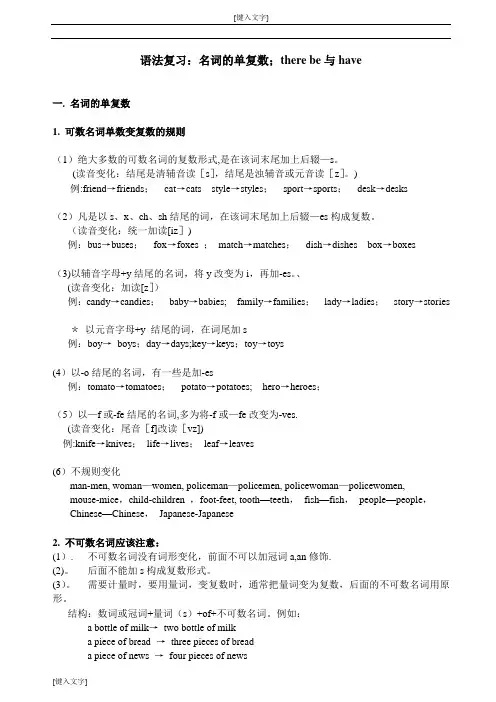
语法复习:名词的单复数;there be与have一. 名词的单复数1. 可数名词单数变复数的规则(1)绝大多数的可数名词的复数形式,是在该词末尾加上后辍—s。
(读音变化:结尾是清辅音读[s],结尾是浊辅音或元音读[z]。
)例:friend→friends;cat→cats style→styles;sport→sports;desk→desks(2)凡是以s、x、ch、sh结尾的词,在该词末尾加上后辍—es构成复数。
(读音变化:统一加读[iz])例:bus→buses;fox→foxes ;match→matches;dish→dishes box→boxes(3)以辅音字母+y结尾的名词,将y改变为i,再加-es。
、(读音变化:加读[z])例:candy→candies;baby→babies; family→families;lady→ladies;story→stories*以元音字母+y 结尾的词,在词尾加s例:boy→boys;day→days;key→keys;toy→toys(4)以-o结尾的名词,有一些是加-es例:tomato→tomatoes;potato→potatoes; hero→heroes;(5)以—f或-fe结尾的名词,多为将-f或—fe改变为-ves.(读音变化:尾音[f]改读[vz])例:knife→knives;life→lives;leaf→leaves(6)不规则变化man-men, woman—women, policeman—policemen, policewoman—policewomen,mouse-mice,child-children ,foot-feet, tooth—teeth,fish—fish,people—people,Chinese—Chinese,Japanese-Japanese2. 不可数名词应该注意:(1). 不可数名词没有词形变化,前面不可以加冠词a,an修饰.(2)。
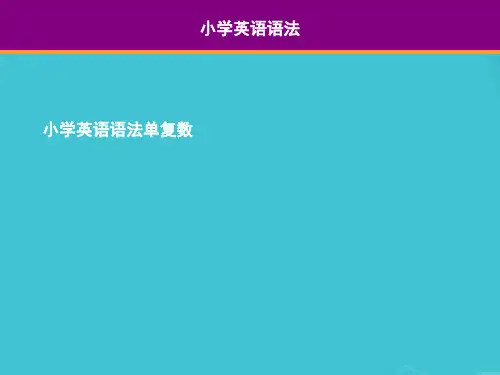
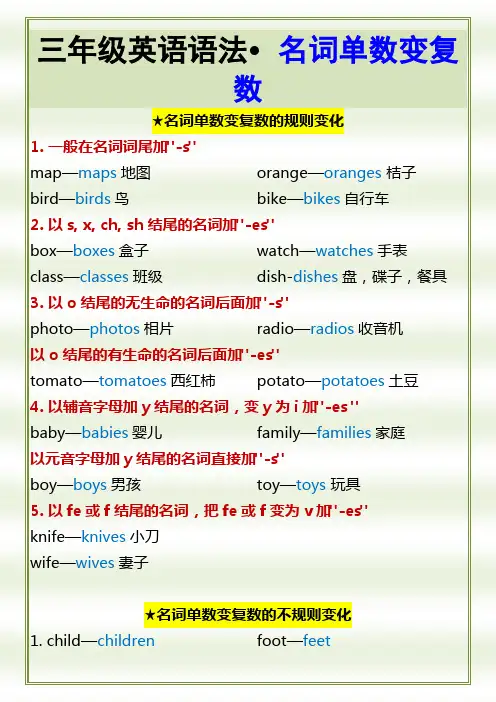

小学英语语法:名词一.名词的定义:1.名词分为专有名词和普通名词。
专有名词是表示具体的人、事物、地点、或机构等的专有名称。
如:GuangZhou,Mike,UNESCO等。
专有名词一般情况下第一个字母要大写,前面不加定冠词the。
普通名词是表示一类人、事物或抽象概念的名称。
如:police,eggs,rice等。
普通名词又可分为个体名词、集体名词、物质名词和抽象名词。
个体名词:表示某一类人或某一类东西中的个体。
如:monkey,panda,ruler,boy等。
集体名词:表示一群人或一些事物的总称。
如:family,police,class,people等。
物质名词:表示无法分为个体或不具备确定形状和大小的实物。
如:Water,air,milk等。
抽象名词:表示抽象概念词。
如:hope,love,spirit。
二.可数名词和不可数名词:1.定义:一般来说,个体名词和集体名词多为可数名词,物质名词和抽象名词多为不可数名词。
2.可数名词的数:可数名词有单数、复数之分,表示“一个”时用单数,a bird,a teacher,an apple,表示“多个”时用复数。
two birds,five teachers,eight apples3.可数名词复数的变化规则口诀:名词单数变复数,直接加-s 占多数;s, x, z, ch, sh 来结尾,直接加上-es;词尾是 f 或fe,加-s 之前先变ve;辅母+ y 在词尾,把y 变i 再加-es;词尾字母若是o,常用四个已足够,要加-es 请记好,黑人英雄吃土豆西红柿. A、一般情况下,在单数名词的后面加-s构成。
如:game-games,boy-boys等。
B、以s、x、sh、ch结尾的单数名词变复数,在词尾加-es构成。
如:box-boxes,bus-buses,peach-peaches,dish-dishes。
C、以o结尾,表示有生命的事物的单数名词变复数加-es;口诀:黑人和英雄吃土豆和西红柿+esnegroes and heroes eat tomatoes and potatoes表示没有生命的事物的单数名词变复数加-s。
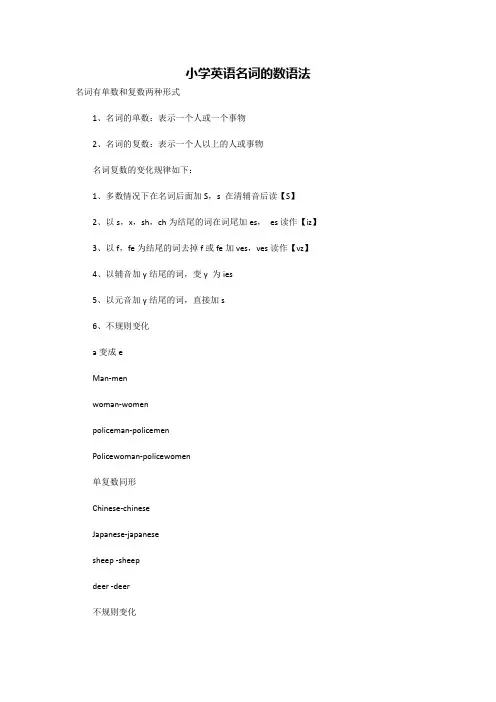
小学英语名词的数语法名词有单数和复数两种形式
1、名词的单数:表示一个人或一个事物
2、名词的复数:表示一个人以上的人或事物
名词复数的变化规律如下:
1、多数情况下在名词后面加S,s 在清辅音后读【S】
2、以s,x,sh,ch为结尾的词在词尾加es,es读作【iz】
3、以f,fe为结尾的词去掉f或fe加ves,ves读作【vz】
4、以辅音加y结尾的词,变y 为ies
5、以元音加y结尾的词,直接加s
6、不规则变化
a变成e
Man-men
woman-women
policeman-policemen
Policewoman-policewomen
单复数同形
Chinese-chinese
Japanese-japanese
sheep -sheep
deer -deer
不规则变化
This 这个these这些(复数)
that那个those那些(复数)
I我we我们(复数)
he他she她it它they他、它、她们(复数) am ,is是are(复数)。
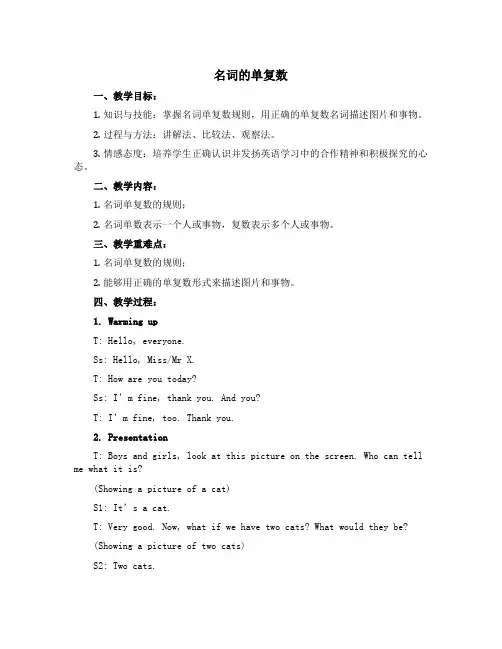
名词的单复数一、教学目标:1.知识与技能:掌握名词单复数规则,用正确的单复数名词描述图片和事物。
2.过程与方法:讲解法、比较法、观察法。
3.情感态度:培养学生正确认识并发扬英语学习中的合作精神和积极探究的心态。
二、教学内容:1.名词单复数的规则;2.名词单数表示一个人或事物,复数表示多个人或事物。
三、教学重难点:1.名词单复数的规则;2.能够用正确的单复数形式来描述图片和事物。
四、教学过程:1. Warming upT: Hello, everyone.Ss: Hello, Miss/Mr X.T: How are you today?Ss: I’m fine, thank you. And you?T: I’m fine, too. Thank you.2. PresentationT: Boys and girls, look at this picture on the screen. Who can tell me what it is?(Showing a picture of a cat)S1: It’s a cat.T: Very good. Now, what if we have two cats? What would they be?(Showing a picture of two cats)S2: Two cats.T: Yes, you are right. In English, when we have one cat, we use the word “cat”. However, when we have two cats, we cannot use “cat” again. We need to change it into “cats”.(Showing the rules of forming plural nouns)T: So, how do we change a singular noun into a plural one?Ss: We add “s”.T: Yes, that’s right. We add “s”. Can you give me some more examples?(Showing pictures of different animals, such as dogs, birds, etc.)T: So, the plural of “dog” is “dogs”, the plural of “bird” is “birds”. That’s the basic rule for forming the plural of most nouns.3. PracticeT: Now, let’s look at some words and decide whether they are singular or plural.(Showing some words on the screen)T: How about “book”?Ss: Singular.T: Yes, how about “books”?Ss: Plural.T: Let’s continue with “pen/pens”, “car/cars”.4. ProductionT: Now, let’s look at some pictures and describe them with singular or plural nouns.(Teacher shows some pictures of different animals and asks students to describe them using singular or plural nouns)5. SummaryT: Today, we learned about the rules for forming the plural of nouns in English. What do we add to make a singular noun plural?Ss: We add “s”.T: Very good. And can you give me an example?Ss: “Cat” becomes “cats”.T: Excellent. You are great students.6. HomeworkT: For homework, you can write some sentences to describe your favorite animals, using singular or plural nouns.五、板书设计:单数名词复数名词book bookspen penscar carscat catsdog dogsbird birds…………六、教学反思:本节课采用讲解法、比较法、观察法等教学方法,生动活泼地诠释了名词单复数的知识点。
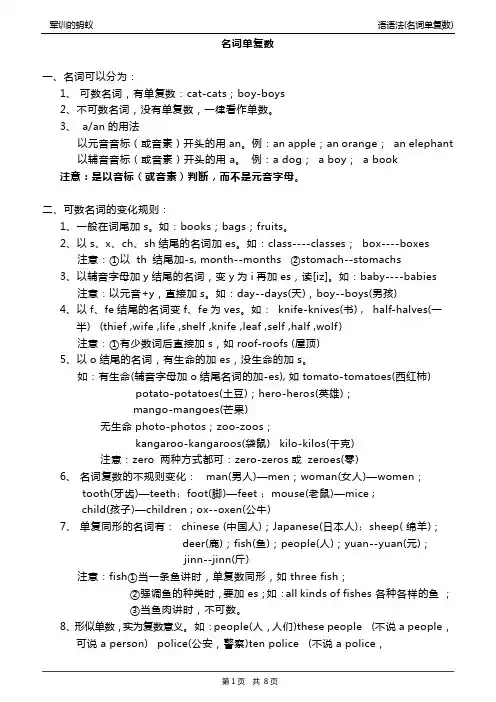
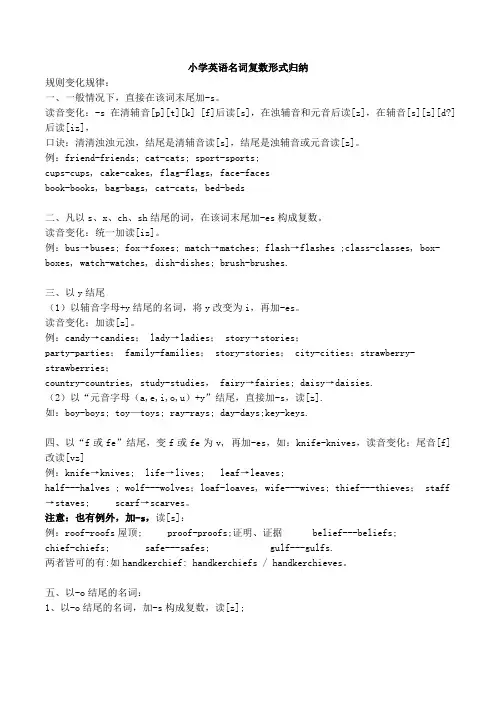
小学英语名词复数形式归纳规则变化规律:一、一般情况下,直接在该词末尾加-s。
读音变化:-s在清辅音[p][t][k] [f]后读[s],在浊辅音和元音后读[z],在辅音[s][z][d?]后读[iz],口诀:清清浊浊元浊,结尾是清辅音读[s],结尾是浊辅音或元音读[z]。
例:friend-friends; cat-cats; sport-sports;cups-cups, cake-cakes, flag-flags, face-facesbook-books, bag-bags, cat-cats, bed-beds二、凡以s、x、ch、sh结尾的词,在该词末尾加-es构成复数。
读音变化:统一加读[iz]。
例:bus→buses; fox→foxes; match→matches; flash→flashes ;class-classes, box-boxes, watch-watches, dish-dishes;brush-brushes.三、以y结尾(1)以辅音字母+y结尾的名词,将y改变为i,再加-es。
读音变化:加读[z]。
例:candy→candies; lady→ladies; story→stories;party-parties; family-families; story-stories; city-cities;strawberry-strawberries;country-countries, study-studies, fairy→fairies; daisy→daisies.(2)以“元音字母(a,e,i,o,u)+y”结尾,直接加-s,读[z].如:boy-boys; toy—toys; ray-rays; day-days;key-keys.四、以“f或fe”结尾,变f或fe为v, 再加-es,如:knife-knives,读音变化:尾音[f]改读[vz]例:knife→knives; life→lives; leaf→leaves;half---halves ; wolf---wolves;loaf-loaves, wife---wives; thief---thieves; staff →staves; scarf→scarves。
小学英语语法:名词一.名词的定义:1.名词分为专有名词和普通名词。
专有名词是表示具体的人、事物、地点、或机构等的专有名称。
如:GuangZhou,Mike,UNESCO等。
专有名词一般情况下第一个字母要大写,前面不加定冠词the。
普通名词是表示一类人、事物或抽象概念的名称。
如:police,eggs,rice等。
普通名词又可分为个体名词、集体名词、物质名词和抽象名词。
个体名词:表示某一类人或某一类东西中的个体。
如:monkey,panda,ruler,boy等。
集体名词:表示一群人或一些事物的总称。
如:family,police,class,people等。
物质名词:表示无法分为个体或不具备确定形状和大小的实物。
如:Water,air,milk等。
抽象名词:表示抽象概念词。
如:hope,love,spirit。
二.可数名词和不可数名词:1.定义:一般来说,个体名词和集体名词多为可数名词,物质名词和抽象名词多为不可数名词。
2.可数名词的数:可数名词有单数、复数之分,表示“一个”时用单数,a bird,a teacher,an apple,表示“多个”时用复数。
two birds,five teachers,eight apples3.可数名词复数的变化规则口诀:名词单数变复数,直接加-s 占多数;s, x, z, ch, sh 来结尾,直接加上-es;词尾是 f 或fe,加-s 之前先变ve;辅母+ y 在词尾,把y 变i 再加-es;词尾字母若是o,常用四个已足够,要加-es 请记好,黑人英雄吃土豆西红柿. A、一般情况下,在单数名词的后面加-s构成。
如:game-games,boy-boys等。
B、以s、x、sh、ch结尾的单数名词变复数,在词尾加-es构成。
如:box-boxes,bus-buses,peach-peaches,dish-dishes。
C、以o结尾,表示有生命的事物的单数名词变复数加-es;口诀:黑人和英雄吃土豆和西红柿+esnegroes and heroes eat tomatoes and potatoes表示没有生命的事物的单数名词变复数加-s。
语法专项练习--名词单复数用法+练习题+答案一、名词:表示某一事物的名词。
1.专有名词:人名,地名,机构等专有的名称,如Beijing、China等。
2.普通名词:①可数名词:可以用数目来计算的具体的个体名词和集体名词。
②不可数名词,无法用数目计算的物质名词和抽象名词。
二、名词变复数(可数名词变复数)1、原理:be 动词如果是am、is或was,名词就用原形;be动词如果是are或were,名词就加s或es。
注意:不可数名词都默认为单数,所以总是用is或者was;最好不要根据 some、any、alot of等作判断,以免受误导。
2、如何加后缀:①一般情况下,直接加-s,如:book-books,bag-bags,cat-cats,bed-beds②以s.x.sh.ch结尾,加-es,如:bus-buses,box-boxes,brush-brushes, watch-watches③以“辅音字母+y”结尾,变y为i,再加-es,如:family-families,strawberry-strawberries④以“f或fe”结尾,变f或fe为v,再加-es,如:knife-knives⑤以元音字母+y结尾的名词变复数时,直接加s变复数,如:monkey---monkeys holiday---holidays⑥以o结尾的名词,变复数时:加s,如:photo---photos zoo---zoos加es如:potatoes,tomatoes⑦不规则名词复数:fish-fish,man-men,woman-women,policeman-policemen,policewoman-policewomen,foot-fe et,child-children tooth-teeth,people-people,Chinese-Chinese,Japanese-Japanese,mouse-mice注意:1)单复同形如:deer,sheep,fish Chinese Japanese 2) 集体名词,以单数形式出现,但实为复数。
名词所有格单复数讲解名词分为不可数名词和可数名词两类。
不可数名词就是没有复数的名词;可数名词就是有单数和复数之分。
一个人或事物为单数,两个或两个以上是复数。
名词变为复数形式的规则如下:1.一般情况是在单数名词后加“-s”,如:pen→pens, sister→sisters.2.以s, sh, ch, x等结尾的单词,变复数形式需加“-es”,如:bus→buses, dish→dishes, watch→watches, box→boxes.3.以f, fe结尾的名词,变复数形式需将f, fe变为ves,如:knife→knives, leaf→leaves.4.以o结尾的词多数都加-es,如:hero→heroes, potato→potatoes, echo→echoes, tomato→tomatoes.少数词加-s,如:zoo→zoos, radio→radios, photo→photos, piano→pianos, kilo→kilos, studio→studios.5.以辅音字母+y结尾的名词,变复数形式需先将y变为i,然后再加“-es”,如:story→stories, factory→factories, family→families.6.单复数同形的名词,如:sheep→sheep, deer→deer, Chinese→Chinese.7.少数名词的复数形式是不规则的,如:man→men, woman→women, child→children, foot→feet,ox→oxen, mouse→mice, tooth→teeth,goos e→geese.英语名词单复数及所涉语法以下这些名词单复数同形:fish鱼,deer鹿,sheep绵羊,works (工厂),means手段,Swiss瑞士人,Chinese中国人只有复数形式的名词trousers裤子,pants裤子,shorts短裤,glasses眼镜,compasses 圆规,scales天平,pliers钳子,clips剪子“某国人”的复数有三种类型:(1)Chinese, Japanese, Swiss 三国人单数复数同形,不需加s;(2)Englishman, Frenchman, Dutchman复数要把man 变为men;(3)其他各国人以–an, -ian收尾的均直接加s。
小学中的常见名词单复数知识点的归纳与解析在学习英语的过程中,掌握名词的单复数形式是非常重要的基础知识。
对于小学生来说,正确运用名词的单复数形式不仅有助于提高语言表达能力,还能够帮助他们更好地理解和学习其他语法知识。
以下是小学中常见名词单复数知识点的归纳与解析。
一、名词的单数形式名词的单数形式一般是指一个人、一个地方或一件事物。
常见的名词单数形式有以下几种:1. 一般名词:大部分名词在单数形式下直接使用,如book(书)、bird(鸟)等。
2. 不可数名词:有些名词是不可数的,表示无法具体数清的事物,如water(水)、milk(牛奶)等。
3. 集合名词:表示一群人或一组事物的名词,如team(团队)、family(家庭)等。
在描述具体数量时,需要使用合适的量词,如a group of(一群)、a bunch of(一束)等。
二、名词的复数形式名词的复数形式是指多个人、多个地方或多件事物。
常见的复数形式有以下几种:1. 一般名词:(1)以s、x、ch、sh、o结尾的名词,一般在末尾加-es,如boxes (盒子)、watches(手表)、buses(公交车)、teachers(老师)等。
(2)以辅音字母+y结尾的名词,将y变为i,再加-es,如butterflies(蝴蝶)、ladies(女士)等。
(3)以f或fe结尾的名词,一般将f或fe变为v,再加-es,如leaves(树叶)、wolves(狼)等。
(4)以元音字母+y结尾的名词,直接加-s,如boys(男孩)、toys (玩具)等。
2. 不规则名词:(1)以-us结尾的名词,一般变为-i,如fungus(真菌)- fungi、cactus(仙人掌)- cacti等。
(2)以-is结尾的名词,一般变为-es,如analysis(分析)- analyses、thesis(论文)- theses等。
(3)部分名词的单复数形式完全不同,需要单独记忆,如man(男人)- men、woman(女人)- women等。
小学英语语法集训之一第一课名词I. 名词分类:可数名词不可数名词1、? 名词分为可数名词和不可数名词。
不可数名词——数不清(没有复数) 例如:drink milk tea water orange juice coke coffee porridge food rice bread meat fish fruit cake dumplings2、可数名词单数前面加不定冠词a(an) ,表示一个,有复数形式,表示复数概念,不可数名词不能与不定冠词a(an) 连用,没有复数形式many “很多” + 可数名词复数much “很多” /a little “一点” + 不可数名词some, any , a lot of (lots of) 两者都可以修饰。
3、可数名词可以直接用数词来修饰不可数名词表示数量时需要用数词+量词+of + 名词对可数名词的数量提问用how many 对不可数名词的数量提问用how much4、不可数名词的量有以下两种表示方法:1) some, much ,a little ,a lot of ,a bit of , plenty of 用等表示多少。
注意既可以与可数名词复数,又可以与不可数名词连用的有:plenty of ,some ,a lot of ,lotsof ,most of 等。
例:There is much water in the bottle.I'll tell you much good news.we should collect some useful information.2) 用单位词表示用a ... of 表示。
如 a cup of (一杯....... ), a bottle of (一瓶.... )a piece of (一张 ..... ),a pair of shoes (一双鞋)如two cups of tea (两杯茶),five pieces of paper (五张纸)注意单位词后的动词单复数形式往往取决于单位词的单复数形式;千、百等数词与名词加用,表示复数时,数词仍保持单数,名词变复数。
如two hundred students (200 名学生)ten thousand trees (10000 棵树)考点He caught a lot of fish 他抓到了许多鱼(此处为许多条鱼,fish 的复数仍为fish )5、可数名词分为单数和复数。
名词单数就是该词本身,在其前面加a 或an 。
1)单数如a desk (一张桌子)an old desk (一张旧书桌)2)复数:要表示一个以上概念时,要用名词复数形式规则变化1)一般情况下加-s 如book —books, desk —desks, cat-cats, bed-beds 2)以s ,x ,ch , sh 结尾加-es 如box —boxes, bus —buses, brush-brushes, watch-watches注意①以th 结尾加-s, month--months② stomach-stomachs3)以辅音字母+结尾,变y 为i 再加- es。
如city--cities(城市) country--countries(国家)注意以元音+y,直接加s。
如:day--days(天),boy--boys(男孩)4)以f或fe结尾,复数变f或fe为v再加-es 如knife-knives(书) , half-halves(一半)(thief ,wife ,life ,shelf ,knife ,leaf ,self ,half ,wolf)注意①有少数词后直接加s,如roof-roofs (屋顶)5)以o 结尾(1)辅音字母加o 结尾名词的加-es如tomato-tomatoes(西红杮) potato-potatoes(土豆)(2)元音字母加o 结尾名词的加-s如piano-pianos (钢琴), zoo-zoos(动物园) photo-photos (照片), kangaroo-kangaroos(袋鼠)kilo-kilos(千克)注意zero 两种方式都可:zero-zeros 或zeroes(零)不规则变化1)元音字母发变化。
如man--men(男人), woman--women(妇女)tooth--teeth(牙齿), foot--feet(脚)mouse--mice(老鼠), policeman--policemen(警察)policewoman--policewomen(女警察)2)词尾发生变化。
如child--children(小孩), ox--oxen(公牛)3)单、复数形式相同。
如fish--fish(鱼), sheep--sheep(绵羊), deer--deer(鹿), Chinese--Chinese(中国人), yuan--yuan(元), jinn--jinn(斤)注意不说an English ,要说an Englishman.①fish作鱼肉讲时不可数,没有复数。
②fishes指各种不同种类鱼或指几条鱼。
4)形似单数,实为复数意义。
如people(人,人们)these people(不说 a people ,可说 a person)police(公安,警察)ten police(不说 a police ,可说 a policeman)5)由man 和woman 构成的合成名词,变复数将名词及man 或woman 都变成复数。
如a man driver-men drivers(男司机)a woman doctor-women doctors (女医生)6)合成名词变为复数时,通常只将里面所含的主体名词变为复数。
如passer-by-passers-by(过路人)bus driver-bus drivers(汽车司机)注意如果没有主体名词,就在最后一词上加-s 。
如:grown-up-grown-ups(成年人) letter-box-letter-boxes (信箱)注意① hair 和fruit 通常作单数,表示总体。
若表示若干根头发或若干种水果,则需用这两个词的复数形式。
如would you like some more fruit? 你要不要再吃点水果?we bought a lot of fruit from the market. 我们从市场上买了许多水果,china has some good frits. 中国有一些好的水果。
(指种类) she has a few white hairs. 她有几要白头发。
his black hair is going white. 他的黑发逐渐变成灰白色。
注意②wind ,snow 和rain这类词,有时也可以有复数形式,表示多次的风、雪或雨。
注意以boy 和girl 开头的复合名词变成复数时,一般只把后一名词变成复数。
如boy student-boy students(男学生) girlfriend--girlfriends(女朋友)7)有些名词只有作复数。
如 scissors(剪刀)a pair of scissors(一把剪刀)trousers(裤子);shorts(短裤);jeans(工装裤);scales(天平),sunglasses(太阳镜);名词+man(woman)构成的复合名词,其复数形式通常与简单名词一样,即把man(woman)改成men(women)。
如Englishman--Englishmen(英国人)Frenchwoman--Frenchwomen(法国妇女)注意German 不是复合词,它的复数是Germans 。
练习:一.写出下列名词的复数形式1. this _____ 2. watch ________ 3. child _______ 4. photo ________ 5. diary _______ 6. day _____ 7. foot _______ 8. dress _________ 9. tooth ______10. sheep _____ 11. box _______ 12. peach ________ 13. sandwich _______14. man _____ 15. woman _________ 16. city ________ 17. zoo _________18. country ____ 19. mouse ________ 20. car ________ 21. fox ________22. tree _____ 23. horse _______ 24. bus ________ 25. leaf ________26. life _____ 27. thief ________ 28. book _________二.按要求填入单词的适当形式1. Two ____ live in this building. (family)2. Look at those _____ . (child)3. I can see a ____ standing near the door. (policeman)4. There are some ____ on the table. (glass)5. Would you like some _____ ? (bread)6. I have two _____ . (sister)7. I like _____ . (cat)8. Do you want some _____ for supper? (potato)9. He has two ____ . One is old, the other is new. (watch)10. In autumn, you can see a lot of ____ on the ground. (leaf)11. I have two ______ . (knife)12. There are two _____ in the zoo. (fox)13. There are many _____ on the road. (bike)14. A few ___ are drawing on the wall. (child)15. The ____ are playing football now. (student)16. Please take two _____ for me. (photo)17. I like the red _____ . (tomato)18. Would you please clean your _____ now? (tooth)19. Do you want some _____ ? (milk)20. There are ten _____ _____ in our school. (English teacher)三.选择下列正确的单词或词组。